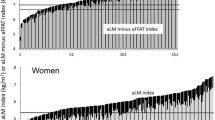Abstract
Previous studies proposed calf circumference cutoff values for predicting dual-energy X-ray absorptiometry (DXA)-derived low muscle mass. However, DXA-derived appendicular lean mass (aLM) includes non-skeletal muscle components such as the appendicular fat-free component of adipose tissue fat cells (aFFAT). The purpose of this study was to compare the calf circumference method of classification before (Model #1) and after (Model #2) eliminating the influence of FFAT in healthy Japanese adults (50 to 79 years; mean age 70 (SD 7) years). Model 1, and Model 2 for classifying low muscle mass had a sensitivity of 78% and 64%, specificity of 76% and 75%, positive predictive value of 31% and 28%, and negative predictive value of 96% and 93%, respectively. Appendicular fat-free component of adipose tissue has the potential to influence the ability of calf circumference to accurately classify individuals with low muscle mass. Consideration should be made when using this as a screening tool for low muscle mass.
Similar content being viewed by others
References
Cruz-Jentoft AJ, Bahat G, Bauer J, et al. Sarcopenia: revised European consensus on definition and diagnosis. Age Ageing 2019;48:16–31.
Paris M, Mourtzakis M. Assessment of skeletal muscle mass in critically ill patients: considerations for the utility of computed tomography imaging and ultrasonography. Curr Opin Clin Nutr Metab Care 2016;19:125–130.
Abe T, Thiebaud RS, Loenneke JP. Simple chart for practical screening of low muscle mass in well-functioning middle-aged and older men and women. Geriatr Gerontol Int 2018;18:657–658.
Kawakami R, Murakami H, Sanada K, et al. Calf circumference as a surrogate marker of muscle mass for diagnosing sarcopenia in Japanese men and women. Geriatr Gerontol Int 2015;15:969–976.
Pagotto V, Santos KF, Malaquias SG, Bachion MM, Silveira EA. Calf circumference: clinical validation for evaluation of muscle mass in the elderly. Rev Bras Enferm 2018;71:322–328.
Rolland Y, Lauwers-Cances V, Cournot M, et al. Sarcopenia, calf circumference, and physical function of elderly women: A cross-sectional study. J Am Geriatr Soc 2003;51:1120–1124.
Abe T, Thiebaud RS, Loenneke JP, Fujita E, Akamine T. DXA-rectified appendicular lean mass: Development of ultrasound prediction models in older adults. J Nutr Health Aging 2018;22:1080–1085.
Heymsfield SB, Gallagher D, Kotler DP, et al. Body-size dependence of resting energy expenditure can be attributed to nonenergetic homogeneity of fat-free mass. Am J Physiol Endo Metab 2002;282:E132–E138.
Abe T, Dankel SJ, Loenneke JP. Body fat loss automatically reduces lean mass by changing the fat-free component of adipose tissue. Obesity (Silver Spring) 2019;27:357–358.
Abe T, Loenneke JP, Thiebaud RS, Fijita E, Akamine T. The impact of DXA-derived fat-free adipose tissue on the prevalence of low muscle mass in older adults. Eur J Clin Nutr 2019;73:757–762.
Diano D, Ponti F, Guerri S, et al. Upper and lower limbs composition: a comparison between anthropometry and dual-energy X-ray absorptiometry in healthy people. Arch Osteoporos 2017;12:78.
Ranganathan P, Aggarwal R. Common pitfalls in statistical analysis: Understanding the properties of diagnostic tests — Part 1. Perspect Clin Res 2018;9:40–43.
Baxter JR, Piazza SJ. Plantar flexor moment arm and muscle volume predict torque-generating capacity in young men. J Appl Physiol 2014;116:538–544.
Abe T, Mitsukawa N, Thiebaud RS, et al. Lower body site-specific sarcopenia and accelerometer-determined moderate and vigorous physical activity: the HIREGASAKI study. Aging Clin Exp Res 2012;24:657–662.
Acknowledgements
Our appreciation is extended to the volunteers who participated in this study. We also thank the graduate students for their assistance in the testing of this study.
Funding
Funding: This study received no specific grant from any funding agency in the public, commercial or not-for-profit sectors.
Author information
Authors and Affiliations
Corresponding author
Ethics declarations
Ethics declaration: All experimental procedures were conducted in accordance with the guidelines in the Declaration of Helsinki and approved by the university’s institutional review board.
Additional information
Conflict of Interest: No conflicts of interest, financial or otherwise, are disclosed by the authors.
Rights and permissions
About this article
Cite this article
Abe, T., Dankel, S.J., Bell, Z.W. et al. Impact of Fat-Free Adipose Tissue on the Prevalence of Low Muscle Mass Estimated Using Calf Circumference in Middle-Aged and Older Adults. J Frailty Aging 9, 90–93 (2020). https://doi.org/10.14283/jfa.2019.34
Received:
Accepted:
Published:
Issue Date:
DOI: https://doi.org/10.14283/jfa.2019.34




